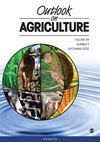UK agriculture at a crossroads
IF 2.6
3区 经济学
Q1 AGRICULTURE, MULTIDISCIPLINARY
引用次数: 0
Abstract
UK farming is at a crossroads. Its continued dependency on decoupled direct payments, shortage of investment finance, difficulties in changing cost structure and the reduced scope to differentiate and diversity sources of farm revenue, exacerbated by the unprecedented increases in the price of key inputs, means farmers face stark choices with fewer remaining effective management options. This study reviews two previous crossroads moments in UK agriculture and considers how the current crossroads moment is different from those. It then provides an estimate of the impacts of the current challenges on the size of the future farming population, based on the methodology used by McInerney. The inter-farm distribution of assets, debts and earnings, differences in farm specialisation, availability of finance and farm-succession arrangements mean it is not easy to identify which individual farms are most likely to fail. Nevertheless, upland grazing, lowland grazing and mixed farm-types seem to be the most vulnerable. Assuming low but realistic returns to fixed and working capital and income/farm, the future farming population is estimated to be 138,000: a 23% reduction from the number of 2019 farming population. The population falls to 15,000 if all subsidies paid in 2021 are removed from the calculation. The actual fall will be smaller than this because farmers will develop new revenue streams and farming systems. But a reduction even approaching 23% is likely to result in more generous assistance being made available, and perhaps even a reversal of some key elements of the new policies.英国农业正处于十字路口
英国农业正处于十字路口。它继续依赖脱钩的直接支付,投资资金短缺,难以改变成本结构,农业收入来源的差异化和多样性缩小,关键投入价格的空前上涨加剧了这种情况,这意味着农民面临着严峻的选择,剩下的有效管理选择更少。本研究回顾了英国农业先前的两个十字路口时刻,并考虑了当前的十字路口时刻与这些时刻的不同。然后,它根据McInerney使用的方法,估计了当前挑战对未来农业人口规模的影响。农场之间的资产、债务和收入分配、农场专业化的差异、资金的可用性和农场继承安排意味着很难确定哪些农场最有可能倒闭。然而,高地放牧、低地放牧和混合农场类型似乎是最脆弱的。假设固定资本、营运资本和收入/农场的回报率低但现实,未来农业人口估计为138000人:比2019年农业人口减少23%。如果将2021年支付的所有补贴从计算中删除,人口将降至15000人。实际降幅将小于此,因为农民将开发新的收入来源和农业系统。但即使削减幅度接近23%,也可能导致提供更慷慨的援助,甚至可能逆转新政策的一些关键要素。
本文章由计算机程序翻译,如有差异,请以英文原文为准。
求助全文
约1分钟内获得全文
求助全文
来源期刊

Outlook on Agriculture
农林科学-农业综合
CiteScore
5.60
自引率
13.30%
发文量
38
审稿时长
>36 weeks
期刊介绍:
Outlook on Agriculture is a peer reviewed journal, published quarterly, which welcomes original research papers, research notes, invited reviews and commentary for an international and interdisciplinary readership. Special attention is paid to agricultural policy, international trade in the agricultural sector, strategic developments in food production, the links between agricultural systems and food security, the role of agriculture in social and economic development, agriculture in developing countries and environmental issues, including natural resources for agriculture and climate impacts.
 求助内容:
求助内容: 应助结果提醒方式:
应助结果提醒方式:


